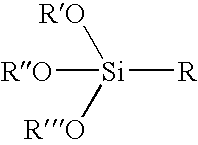Alkaline phenolic resole resin compositions and their use
a technology of alkaline phenolic resole and resin composition, which is applied in the direction of detergent compounding agents, foundry patterns, moulding apparatus, etc., can solve the problems of crust breaking mechanically, aqueous basic solutions of phenolic resins are not stable, and aqueous basic solutions of phenolic resins are prone to skin formation, etc., to reduce long term tensile strength, reduce odor, and avoid urea
Inactive Publication Date: 2010-10-07
ASK CHEM LP
View PDF12 Cites 6 Cited by
- Summary
- Abstract
- Description
- Claims
- Application Information
AI Technical Summary
Benefits of technology
[0007]The alkaline phenolic resole resin compositions are storage stable and not prone to skin formation because the alkaline phenolic resole resin compositions do not crust and flakes do not form. Consequently, agitation of the alkaline phenolic resole resin composition is not required and filters are not clogged when the alkaline phenolic resole resin composition is pumped to the mixer where the alkaline phenolic resole resin composition is combined with an aggregate from which foundry cores and molds are made.
Problems solved by technology
It is also known that aqueous basic solutions of phenolic resins are not stable over time, particularly if the resin is exposed to warmer temperatures.
It is also known that aqueous basic solutions of phenolic resins are prone to skin formation, i.e. the formation of a crust on the surface of the resin in the storage container.
If a crust forms on the surface of the resin solution, this crust breaks down mechanically when the resin is used and forms flakes which sink to the bottom of the storage container.
Because from a practical perspective it is difficult to dissolve these flakes by agitation, the flakes clog filter screens when the resin solution is pumped to a mixer where it is mixed with an aggregate such as sand and, in case of a no-bake process, also a co-reactant, to form the mixture which is then used to produce the foundry shapes.
The problem with using surfactants is that they do not work satisfactorily or they cause other problems such as phase separation when the resin is exposed to low temperatures.
Method used
the structure of the environmentally friendly knitted fabric provided by the present invention; figure 2 Flow chart of the yarn wrapping machine for environmentally friendly knitted fabrics and storage devices; image 3 Is the parameter map of the yarn covering machine
View moreImage
Smart Image Click on the blue labels to locate them in the text.
Smart ImageViewing Examples
Examples
Experimental program
Comparison scheme
Effect test
example 5
[0032]In this example, samples of alkaline phenolic resin solutions were added to clear containers and allowed to sit for 1 week. Skin / flake buildup had formed on the sides of the containers to varying degrees with less forming in the samples with increased amounts of glycerol. The samples were then agitated for one minute. After 30 minutes, the samples with glycerol had considerable less undissolved skin / flake buildup than the control sample.
the structure of the environmentally friendly knitted fabric provided by the present invention; figure 2 Flow chart of the yarn wrapping machine for environmentally friendly knitted fabrics and storage devices; image 3 Is the parameter map of the yarn covering machine
Login to View More PUM
| Property | Measurement | Unit |
|---|---|---|
| weight percent | aaaaa | aaaaa |
| viscosity | aaaaa | aaaaa |
| temperatures | aaaaa | aaaaa |
Login to View More
Abstract
Description
RELATED APPLICATIONS[0001]This application claims priority to U.S. Provisional Patent Application Ser. No. 61 / 167,357, filed Apr. 7, 2009.BACKGROUND[0002]It is known to use aqueous basic solutions of phenolic resins to make foundry shapes. Cured foundry shapes comprising aqueous basic solutions of phenolic resins can be made by the no-bake or cold-box process using liquid esters or vapors of volatile esters as the co-reactant, or using carbon dioxide. See for instance U.S. Pat. Nos. 4,468,359, 4,474,904, and 4,977,209.[0003]It is also known that aqueous basic solutions of phenolic resins are not stable over time, particularly if the resin is exposed to warmer temperatures. Evidence of the instability of the resin is reflected in a viscosity increase in the resin, which indicates that the molecular weight of the resin is increasing.[0004]It is also known that aqueous basic solutions of phenolic resins are prone to skin formation, i.e. the formation of a crust on the surface of the re...
Claims
the structure of the environmentally friendly knitted fabric provided by the present invention; figure 2 Flow chart of the yarn wrapping machine for environmentally friendly knitted fabrics and storage devices; image 3 Is the parameter map of the yarn covering machine
Login to View More Application Information
Patent Timeline
 Login to View More
Login to View More Patent Type & Authority Applications(United States)
IPC IPC(8): B22C9/00B22C1/22C11D3/20
CPCB22C1/2253C08K5/053C08L61/06
Inventor BANGCUYO, CARLITO G.ROPP, TIMOTHY A.KROKER, JORG
Owner ASK CHEM LP
Features
- R&D
- Intellectual Property
- Life Sciences
- Materials
- Tech Scout
Why Patsnap Eureka
- Unparalleled Data Quality
- Higher Quality Content
- 60% Fewer Hallucinations
Social media
Patsnap Eureka Blog
Learn More Browse by: Latest US Patents, China's latest patents, Technical Efficacy Thesaurus, Application Domain, Technology Topic, Popular Technical Reports.
© 2025 PatSnap. All rights reserved.Legal|Privacy policy|Modern Slavery Act Transparency Statement|Sitemap|About US| Contact US: help@patsnap.com

